Via hole protection is a PCB manufacturing technique in which the via hole is filled with solder mask or epoxy. This process partially or completely closes the via hole using a conductive or non-conductive filling material. Filling via holes results in more reliable surface mounts, provide better assembly yields and improve reliability of the PCB by decreasing the probability of trapped air or liquids in the via and thus the PCB Board.
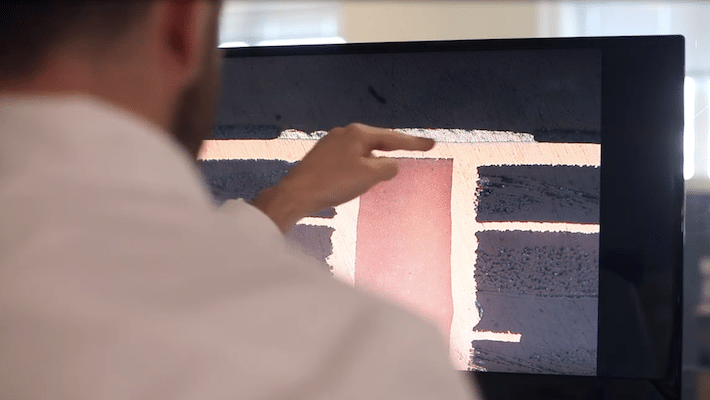
Are there different types of via hole plugging or protection? Are there variants when calling for a ‘plugged’ via? Yes there are. In fact there are seven types of via hole ‘protection’. Some are recommended and some are not, some are necessary for certain technologies, and all have different ‘names’. In this text, we will explain some of them.
What is a via?
A via is a plated through hole (PTH) in a PCB that is used to provide electrical connection between a trace on one layer of the printed circuit board to a trace on another layer. Since it is not used to mount component leads, it is generally a small hole and pad diameter. The following are the two processes that can achieve this.
No 1: Soldermask covered (Tented)
A via tenting is nothing more than covering its annular copper ring with solder resist, also known as LPI (Liquid Photo Imageable) ink. PCB designers need to remove the solder mask opening from its via in their design, which enables via tenting. This is why it’s considered standard and won’t increase the price of the PCB. In this process, we can only ensure that the annular copper ring is covered with solder resist ink. The surface of the hole may or may not be covered with the solder resist ink.
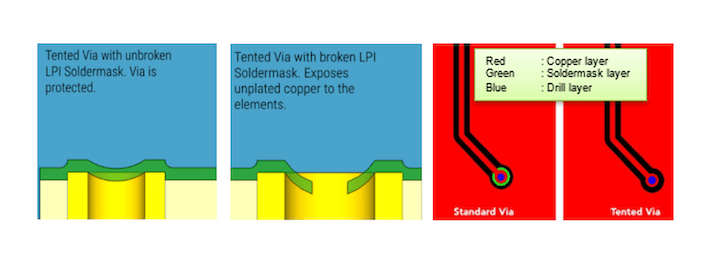
It is very important to note that the smaller the via hole size, the better the result will be. Suggested is a via >=0.20mm. Via hole sizes less than 0.3mm have the best chance of getting filled, while between 0.3mm to 0.5mm sizes, filling results may vary. Because this is an uncontrolled process, it is not recommended when holes need to be closed.
Advantages:
- No cost involved because via filling is achieved during the standard PCB process (screen printing process costs extra).
- See Table 1 for the main benefits, degree of certainty and cost drivers.
Disadvantages:
- Not suitable if a design demands 100% guaranteed filled via.
- Not suitable for Via In Pad process (for active via) and therefore not recommended for highly-complex designs having a fine pitch BGA.
No 2: Soldermask filling
Compared to tented vias, via holes are also filled with solder resist ink (LPI) in this process.
Screen printing process
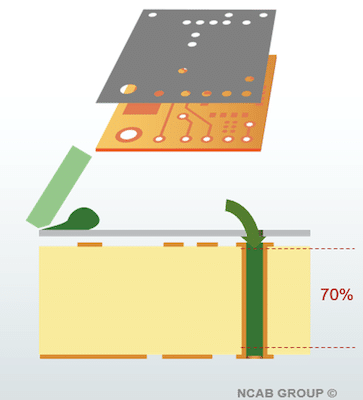
In this process, a drilled ALU sheet is used to push standard solder resist ink (LPI) into the via holes that need to be filled. The normal solder mask process is carried out after this screen printing process. 100% guaranteed result is assured in this process.
Advantages:
- Less expensive in cost compared to via plugging (conductive or non-conductive) process.
- This makes it ideal if it’s just about filling vias with 100% certainty.
- See Table 1 for the main benefits, degree of certainty and cost drivers.
Disadvantages:
- Not suitable for Via In Pad process (i.e. for active via)
Via Hole Protection (Via In Pad – conductive or non-conductive)
To manufacture products that are more and more compact and advanced, electronic engineers are facing a challenge to design circuit boards that are smaller without compromising performance. Therefore, BGA packages with smaller pitch or clearances are becoming more popular. Instead of using the standard “dog bone” footprint, where signals are transferred from the BGA pad to a via and then from the via to other layers, the via can be drilled directly into the BGA pad. This makes the routing of track work tighter and easier in designing PCBs as the surface of via itself becomes BGA pad allowing it to be treated as a normal SMD pad for soldering. This process is called “Via In Pad” while the pad is called an “Active Pad”.

Overall, there are two types of via protection available depending on the material used in the process; non-conductive via filling and conductive via filling. Out of these two, the most common and widely preferable is non-conductive via filling.
Conductive Via Protection
For PCB designs that require to transfer high amount of heat or current from one side of the board to another, conductive via filling is a handy solution. It can also be used to dissipate excessive heat generated underneath some components. The metallic nature of the fill will naturally wick heat away from the chip to the other side of the board in many ways like a radiator. Advantages:
- Heat sink or transfer where other conventional methods are impractical e.g. underneath the chip component.
- Increased current carrying capacity due to higher thermal conductivity (between 3.5 to 15 W/mK) of the conductive material.
Disadvantages:
- High instability of copper pad and copper plating inside the via hole barrel. This occurs due to the difference in CTE (coefficient of thermal expansion) value of conductive material and laminate surrounding it. When the PCB goes through thermal cycles, metal will heat and expand more rapidly than surrounding laminate, which can cause a fracture between pad and via hole barrel and lead to an open circuit
- Thermal conductivity is not too high (compared to electroplated copper that has thermal conductivity of more than 250W/mK) so it is possible to add a few more vias and avoid this process to more reliable non-conductive via plugging
- More expensive than non-conductive via protection
- Not in high demand so minimal manufacturers can supply
Non-Conductive Via Protection or Epoxy Resin Protection
This is the most common and popular method of via plugging, especially for Via In Pad process. The barrel of via hole is filled with non-conductive material. Selection of the material depends on the CTE value, availability, specific design requirements and type of process. Thermal conductivity of non-conductive material is normally close to 0.25 W/mK. A common misconception about non-conductive via treatment is that the via will either not pass any current or only a weak electrical signal, which is absolutely not correct. The via will still be plated as normal before non-conductive material is filled inside. It means vias will work as normal as in any other standard PCB.
Advantages:
- Prevents solder or any other contaminants from entering into via
- Provides strength and structural support to active pads (Via In Pad process)
- Offers better stability and reliability of pad and via due to close match of CTE between filling material and surrounding laminate when comparing the same with conductive material
What via hole protection does NCAB Group recommend?
When the procurement documentation calls for via protection but doesn’t specify which method should be used, then via hole treatment shall be as per IPC-4761 Type VI (filled and covered) and shall always take place before soldermask and surface finish.
Blind vias
Blind vias are vias from the outer layer to the first inner layer. If the vias are very small and drilled with a laser, we call them microvias as well. If these are placed in a pad, then normally the manufacturer fills these with copper. Some manufactures fill these with epoxy and copper cap them. We don’t specify a special IPC-4761 type for the blind vias. Within the filled via structures a filled and capped construction can be applied for via in pad needs. The filled and capped via constructions is a via Type V with a secondary metallized coating covering the via. Benefit of this via construction are Via-in-pad, Ball-on-pad and Via-stacking in multilayer construction, very useful in sequential lamination processes. The processing of via filled and capped (Type VII) is more complicated and expensive compared to previous via types due to extra drill, grinding/brushing/polishing and plating.
| Key advantages | Via tenting, type I & II | Via plugging method: Screen printing, type III / IV | Via protection method: Non-Conductive or Conductive filling, type V | Via protection method: Non-Conductive or Conductive filling, type VI | Via protection method: Non-Conductive or Conductive filling & copper capped, type VII |
|---|---|---|---|---|---|
| Prevents solder from entering the via and over the other side of PCB where it can potentially short components during wave solder process | 100% Not Assured | 100% Assured | 100% Not Assured | 100% Assured | 100% Assured |
| Prevents the solder paste from entering the via and creating a poor solder joint where vias are close to SMD pads – this can affect the dog bone style of the BGA | 100% Not Assured | 100% Assured | 100% Not Assured | 100% Assured | 100% Assured |
Via treatment is something that can be very important for your PCB, but a lot of times the designer doesn’t really know all the available via protection types and which type to specify. Only specifying that the vias must be ‘filled’ or ‘plugged’ is something we do not recommend. This makes it not only confusing for the designer, but also for the manufacturer.
Instead of only specifying ‘filled’ or ‘plugged’ we recommend to specify a certain IPC-4761 via type. These types make it easy to understand for both the designer and the manufacturer and therefore you know what to expect from your vias. The IPC-4761 only specifies via types for mechanically drilled vias, but not for microvias which are laser drilled. Microvias will always be copper filled if these are placed in the pad of a component or if another microvia is stack on top of it.
IPC-4761 specifies 7 different types of vias:
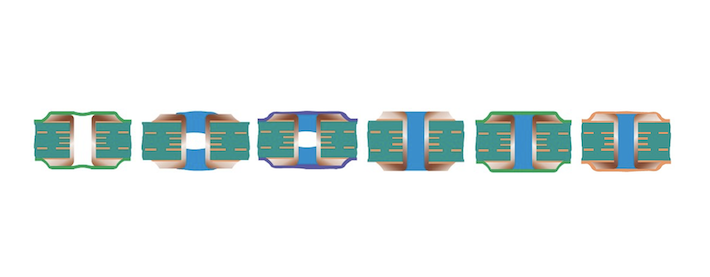
Tended (Via Type I-a/-b) and Tented and covered (Via type II-a/-b)
A via with a dry film mask material applied bridging over the via wherein no additional materials are in the hole. Via type II is Via type I with an additional cover. Prior to surface finish. Type II is not supported anymore
Plugged (Via Type III-a/-b)
A via or through hole with material applied allowing partial penetration into the via or through hole. The plug material may be applied from either one or both sides of the via structure. (Prior to surface finish.)
Plugging and covered (Via Type IV-a/-b)
A via or through hole with a secondary covering of mask material applied over the plugged via. The material may be applied from either one or both sides of the via structure. (Prior to surface finish.)
Filled (Via Type V)
A via or through hole with material applied into the via or through hole targeting a full penetration and encapsulation of the hole. (Prior to surface finish.)
Filled and covered (Via Type VI)
A via or through hole with a secondary covering of material applied over the filled via or through hole. The material may be applied from either one or both sides of the via structure. (Prior to surface finish.)
Filled and capped (Via Type VII)
A via or through hole with a secondary metallized coating covering the via or through hole. The material may be applied from either one or both sides of the via structure. (Prior to surface finish.)
‘For tented and plugged via types “-a” stands for single sided and “-b” stands for both sides of application.
A type I via is tented during the soldermask process. The downside is that the manufacturer cannot guarantee that the hole is 100% closed. As you can see in the picture on the right, there’s a chance of exposed copper. If you specify this via type, please tent the vias from both sides instead of only one side.
Type III and IV can be specified if you want an inexpensive solution to close the via hole 100%. The via will be plugged from one or both sides.
A Type V or VI vias will be filled with a substance which is normally soldermask or epoxy. IPC does not give a requirement in terms of depth of fill, but NCAB does: Boards which are 1.60mm thick, with via holes ranging from 0.25mm to 0.50mm, the target condition is 100% fill, however we consider it acceptable if > 70% fill is achieved.
Nowadays the price is more important than ever. It is therefore important to specify the right IPC-4761 type.
Before specifying it, please ask yourself what you require from the via. Do I need to place the through hole via inside a pad? Do I only require the via to be closed 100%? What’s the size of the via and is it actually too large to be filled?
Please contact your local NCAB office if you have questions regarding via hole plugging, and we can help you specifying the right type.
Want to learn even more about microvias?
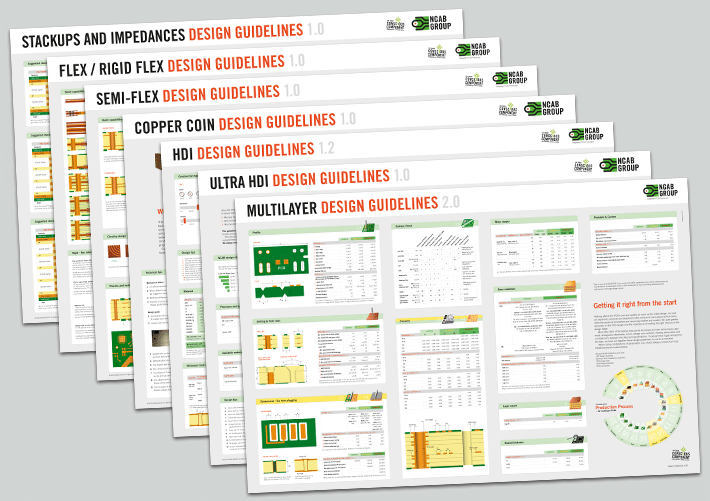
PCB design guidelines
Get it right from the start with our PCB design guidelines. To prevent getting it wrong from the start, we have put together our design guidelines, to use as a checklist.
